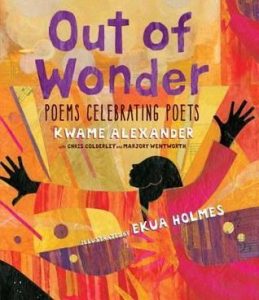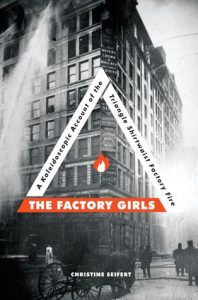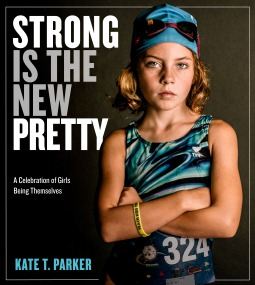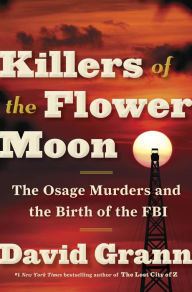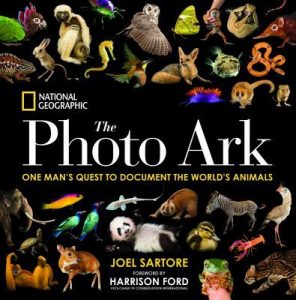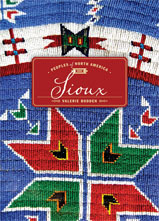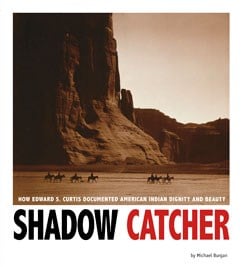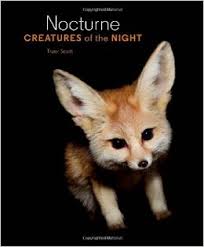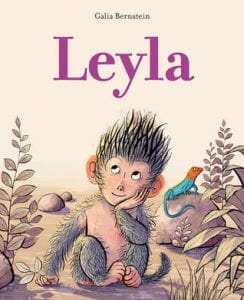 Bernstein, Galia. Leyla. Abrams, 2019. 978-1-419-73543-1. 32 p. $16.99. Grades K-3.
Bernstein, Galia. Leyla. Abrams, 2019. 978-1-419-73543-1. 32 p. $16.99. Grades K-3.
Leyla is a little baboon with a big family. Her troop includes not only her mother and father but also nine aunts and twenty-three cousins! Since she has such a large family, there is always someone around. Someone to hug her, kiss her, and groom her. And, there’s always someone talking – even when it’s her naptime. One day, Leyla can’t take it anymore, and she runs away from all the noise and all the commotion. She runs until she finds total peace and quiet. In the quiet place, she befriends a lizard who shows her how to simply “be.” The meditation does Leyla good, but it also makes her realize that she misses her boisterous family. Promising to visit the lizard again when she needs some peace and quiet, Leyla returns to her family. They welcome her with open arms and lots of kisses. When life gets noisy again, Leyla remembers her afternoon with the lizard and their strategy for finding inner peace.
THOUGHTS: This title would be a good fit for elementary morning meetings since it focuses on what to do when one is feeling overwhelmed. It also validates the idea of taking a break from life’s chaos and doing nothing for a while. Leyla’s cool-down strategies can easily be replicated in the classroom, and her dilemma of how to deal with her feelings of life sometimes being too much will be relatable for many children.
Picture Book Anne Bozievich, Southern York County SD
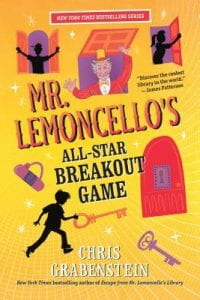 Grabeinstein, Chris. Mr. Lemoncello’s All-Star Breakout Game. Random House: 2019. 978-0-525-64644-0. 261 p. $16.99. Grades 3-6.
Grabeinstein, Chris. Mr. Lemoncello’s All-Star Breakout Game. Random House: 2019. 978-0-525-64644-0. 261 p. $16.99. Grades 3-6.
Kyle and his friends at Alexandriaville Middle School are excited for the newest challenge from game mogul Luigi Lemoncello. The All-Star Breakout Game is limited to two teams from the middle school, and once again Kyle is pitted against arch-enemy Charles Chiltington, along with a team of stars from the Kidzapalooza TV network, in a contest to play their way out of Mr. Lemoncello’s fabulous library. The game features the library’s new Fictionasium, an interactive Virtual Reality world that allows the teams to create their own story as they collect clues to unlock five locks and be the first to escape the library. While much about this fourth entry in the entertaining Mr. Lemoncello’s Library series is familiar territory, Grabenstein also focuses on character development. As Kyle’s friend Sierra says, quoting Atticus Finch, “You never really understand a person until you consider things from his point of view…until you climb into his skin and walk around in it.” Kyle learns why Charles is driven to succeed at all costs, as well as gaining some insight into the lives of kid TV personalities. As always, Kyle’s loyalty to his friends and his innate fairness, contribute to the conclusion of the game. Grabenstein includes a game for readers as well: can you find the over 70 book titles mentioned throughout the novel? A complete list is at the end of the story and may lead readers to many other books.
THOUGHTS: A high-energy ode to libraries and books. Purchase where other titles are popular. While this book works as a stand-alone, readers of the complete series will enjoy reconnecting with the characters.
Adventure Nancy Nadig, Penn Manor SD
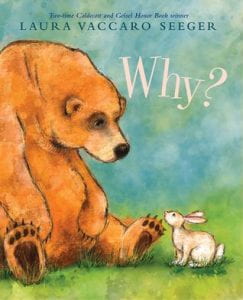 Seeger, Laura Vaccaro. Why? Neal Porter Books, 2019. 978-0-823-44173-0. Unpaged. $18.00. Grades PreK-2.
Seeger, Laura Vaccaro. Why? Neal Porter Books, 2019. 978-0-823-44173-0. Unpaged. $18.00. Grades PreK-2.
Laura Vaccaro Seeger is well known to many of us, but this book’s illustrations stray from her typical fare as she uses lovely watercolors to show a curious rabbit with a never-ending stream of “Why?” questions. Friend bear patiently provides answers to rabbit’s questions focused on growing plants, beautiful summer weather, falling leaves, migrating birds, and other signs that seasons are changing in the forest. As snow starts falling and a sleepy bear reaches the end of his answers (and perhaps his patience!), rabbit begs bear not to go. “Why?” questions the bear, and roles reverse as rabbit explains that he will miss his friend. This story will surely resonate with parents of toddlers and curious kids with their own never-ending streams of why questions.
THOUGHTS: A simple friendship story with lots of discussion/prediction possibilities in a preschool or young elementary classroom.
Picture book Lindsey Long, Lower Dauphin SD
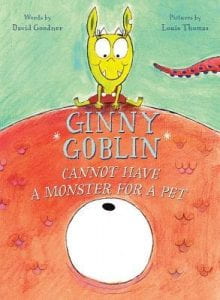 Goodner, David. Ginny Goblin Cannot Have a Monster For a Pet. Houghton Mifflin Harcourt, 2019. 978-0-544-76416-3. Unpaged. $17.99. Grades PreK-2.
Goodner, David. Ginny Goblin Cannot Have a Monster For a Pet. Houghton Mifflin Harcourt, 2019. 978-0-544-76416-3. Unpaged. $17.99. Grades PreK-2.
Ginny Goblin wants a pet. The problem? She loves goats. The narrator explains to readers that goats are smelly and perhaps we readers can help Ginny Goblin find a different pet. The new problem? Ginny employs her powers of cunning and creativity to take each search to the extreme, turning a beachside hunt for a hermit crab into a deep sea dive to find a giant kraken and birdwatching during a forest stroll into a haunted forest basilisk hunt. After several failed attempts to bring a monster home, Ginny Goblin suggests a smaller, cuter option. A goat, of course! Children will delight in Ginny’s silly antics during pet hunting and will certainly giggle at Ginny’s final bit of trickery.
THOUGHTS: Read this to some kindergarteners in need of a good giggle.
Picture book Lindsey Long, Lower Dauphin SD
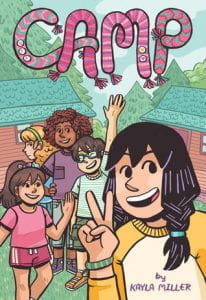 Miller, Kayla. Camp. Houghton Mifflin Harcourt, 2019. 978-1-725-42526-2. 213 p. $24.99. Grades 3-5.
Miller, Kayla. Camp. Houghton Mifflin Harcourt, 2019. 978-1-725-42526-2. 213 p. $24.99. Grades 3-5.
Fans of Kayla Miller’s Click and readers new to the series will love Olive’s new adventure in Camp. Olive and pal Willow head to Camp Acorn Lake for two weeks in the bunny bunk, and Olive brings her typical enthusiasm for new friends and diverse activities, from jewelry making to softball to video. Willow is more of an “indoor-kid,” camp speak for kids who aren’t so into sports and nature activities. Olive dives into camp life and makes lots of new friends while Willow is homesick and clings tighter and tighter to Olive as the days pass. Olive is torn between being a good friend to Willow and wanting to branch out and enjoy her own time and interests that might not include Willow. After an eruption at the Halfway Day dance, Olive and Willow spend a few days apart. Without Olive to cling to, Willow finds her own niche (the drums–who knew!) and actually enjoys her last few days at camp, and Olive gets to try out some new activities like skateboarding. Ultimately, however, they patch things up after an honest heart-to-heart. Miller excels at realistic friendship stories and upper elementary/early middle school students will surely find something relatable at Camp Acorn Lake. Bonus–extra pages in the back of the book show a map of Camp Acorn Lake and how-to’s for some of Olive and Willow’s favorite camp activities.
THOUGHTS: An excellent new graphic novel series, hand Camp to fans of the first book or readers who like Gale Galligan’s Baby-Sitters Club series for a surefire hit.
Graphic Novel Lindsey Long, Lower Dauphin SD
 Galligan, Gale. Boy-Crazy Stacey (The Baby-Sitters Club). Graphix, 2019. 978-1-544-43492-6. 159 p. $25.00. Grades 3-6.
Galligan, Gale. Boy-Crazy Stacey (The Baby-Sitters Club). Graphix, 2019. 978-1-544-43492-6. 159 p. $25.00. Grades 3-6.
Stacey and Mary Anne can’t wait to visit Sea City. They’re baby-sitting the Pike kids for two weeks while the family vacations in New Jersey, and that will mean fun on the beach, the boardwalk, and crazy days with lots of kids running around. It’s a baby-sitter’s dream! Unfortunately for Mary Anne, Stacey spies a cute lifeguard early in their trip and spends most of her time hanging around the stand talking to cute, older lifeguard Scott, leaving Mary Anne to do double baby-sitting duty. Two weeks fly by in a blur of Burger Garden dinners, boardwalk nights, sibling woes, and tension between the baby-sitters, but after Stacey spots Scott with another girl she snaps back to reality and realizes she’s been slacking. The baby-sitters patch things up and enjoy their last few days in Sea City with the kids and a few special new friends. Like the other books in the graphic novel series, Boy-Crazy Stacey holds true to Ann M. Martin’s original BSC book that many of us remember and love from years past, down to Stacey’s heart-topped i’s. Small updates make the book current–when Mary Anne gets terribly sunburned, the Pike kids bring items to help soothe her discomfort and Claire brings peanut butter (“It’s yummy”) rather than butter, an old-fashioned remedy for regular burns, which wouldn’t make much sense to kids in 2019. A solid addition to the series!
THOUGHTS: BSC fans will gobble up Galligan’s latest offering.
Graphic Novel Lindsey Long, Lower Dauphin SD
 Knapp, Andrew. Find Momo Across Europe. Quirk Books, 2019. 978-1-683-69106-8. 134 p. $14.95. Grades 3+.
Knapp, Andrew. Find Momo Across Europe. Quirk Books, 2019. 978-1-683-69106-8. 134 p. $14.95. Grades 3+.
Andrew Knapp and his excellent-at-hiding border collie, Momo, are back! This time, their adventures take them on an extended road trip across Europe. Knapp documents their travels with hide-and-seek photographs of Momo in and amongst some of Europe’s most beautiful scenery and iconic tourist attractions. Every chapter in their “Road Map” (each featuring two or three countries) opens with some background and dog-friendly highlights from their time in that region. Their stops include Portugal, Italy, Albania, Croatia, Wales, and more. Readers will delight in spotting Momo as he peeks out from behind bushes, boulders, and bicycles!
THOUGHTS: The Find Momo books are a delight for all ages. They are a great choice for struggling readers and avid readers alike. They work especially well as a breather in between more text-heavy selections, or as a book club option for groups with varying reading levels. There are even more interactive hide-and-seek photographs at letsfindmomo.com.
793 Picture Puzzles, Dogs Amy V. Pickett, Ridley SD
 Rogers, Fred. A Beautiful Day in the Neighborhood: The Poetry of Mister Rogers. Quick Books, 2019. 141 p. 978-1-683-69113-6. $19.99. Grades PreK-1.
Rogers, Fred. A Beautiful Day in the Neighborhood: The Poetry of Mister Rogers. Quick Books, 2019. 141 p. 978-1-683-69113-6. $19.99. Grades PreK-1.
This work is a collection of 75 songs that were performed on the TV show Mister Rogers’ Neighborhood as seen on PBS. Although the title names them poems, they are actually songs written by either Fred Rogers or Josie Carey, a host of children’s shows and another Pittsburgh native. Per the index, the songs cover such topics as self-esteem, curiosity, fears and worries, feelings, making mistakes, and being special. Mister Rogers strove to reassure young children that each one of us is special in our own way. Each poem is accompanied by colorful illustrations by Luke Flowers. Sometimes the rhymes seem forced, but that is probably because they are better sung. The book itself might have been even more impressive if a CD recording of Rogers’ singing these songs himself was part of the package. With the coming of the Mister Rogers’ movie starring Tom Hanks, this text will be of more interest.
THOUGHTS: This collections of songs/poems will be useful to preschool and kindergarten teachers who can use them in their lessons and activities.
811.6 21st Century Poetry Denise Medwick, Retired, West Allegheny SD
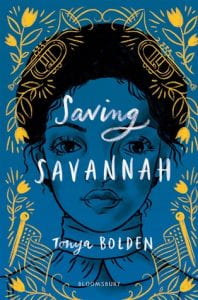 Bolden, Tonya. Saving Savannah. Bloomsbury, 2020. 978-1-681-19804-0. $17.99. Grades 6-8.
Bolden, Tonya. Saving Savannah. Bloomsbury, 2020. 978-1-681-19804-0. $17.99. Grades 6-8.









